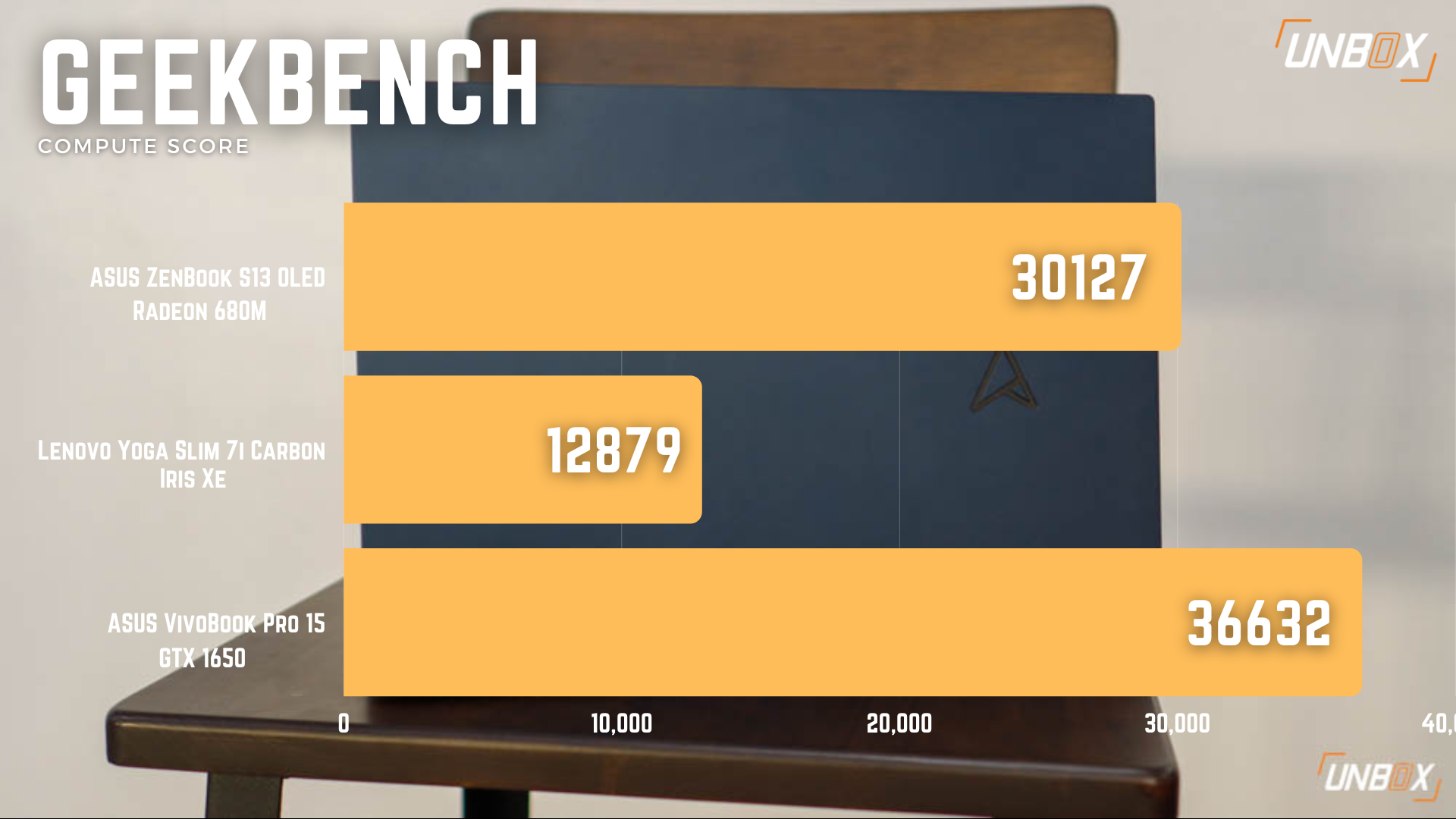Review Verdict: The use of AMD’s Ryzen 6000 series processors gives the ASUS ZenBook S 13 OLED even better value for money for a premium ultrabook in the Philippines. Aside from a significantly better price-per-performance compared to its predecessor, it has a stellar battery life and a best-in-class display. Overall, it is the closest competitor of the MacBook Pro M2 in terms of price to performance.
Pros
- Stellar performance from the Ryzen 6800U CPU and Radeon 680M GPU
- Best-in-class display
- One of the best battery life we’ve seen on a laptop recently
Cons
- Only USB-C ports are available in the chassis
Just like its main ZenBook line, its premium S-series models get a much-needed makeover with the S 13 OLED (UM5302). Aside from a design refresh, the ZenBook S13 OLED (UM5302) utilizes AMD’s 4nm-based Ryzen 6000 processors that come with an all-new Radeon integrated GPU that’s based on RDNA 2 architecture. Are these upgrades–along with a lower price tag–make the ZenBook S 13 OLED (UM5302) a great premium ultrabook?

Design
The ZenBook S 13 OLED (UM5302) uses ASUS’ new design language, where the lid has the brand’s monogram logo–though in a smaller and more straightforward design instead of the oversized, artistic approach we saw on the UX3402. You still have ASUS’ trademark ErgoLift hinge on the ZenBook S 13 OLED (UM5302), though this time the chassis now tilts up to a full 180 degrees.
There are four color options for the ZenBook S 13 OLED (UM5302), and our review unit came in ASUS’ defacto Ponder Blue trademark color for its ZenBook line. The ZenBook S 13 OLED (UM5302) is very light at under 1kg, thanks to its magnesium-aluminum alloy chassis. Despite being very light, the ZenBook S 13 OLED (UM5302) feels very solid.
Since the ZenBook S 13 OLED (UM5302) has a thinner chassis than the ZenBook 14 OLED (UX3402) we previously reviewed, your port selection is limited to just four USB-C 3.2 Gen 2 ports and a headphone jack. To compensate for that, ASUS includes a USB-C to USB-A dongle, so you can still use the ZenBook S 13 OLED (UM5302) with devices that still use the older USB-A port.

Keyboard and trackpad
Despite being smaller than the ZenBook 14 OLED (UX3402), the ZenBook S 13 OLED (UM5302) uses virtually the same keyboard design and layout. The only difference is that the keyboard on the ZenBook S 13 OLED (UM5302) is closer to the edge due to its smaller footprint.
Having the same keyboard layout also means that the ZenBook S 13 OLED (UM5302) uses ASUS’ updated keycap design, which is an improvement over previous ZenBook models, where the keys have a more tactile and satisfying feel when using them–including while writing this review. That’s an impressive feat for ASUS considering that the ZenBook S 13 OLED (UM5302) is less than 15mm thin.

The same goes for the trackpad, as the ZenBook S 13 OLED (UM5302) comes with a virtual Numpad. ASUS normally reserves its NumberPad feature on its 14-inch ZenBook models, and we’re surprised to see the feature make it to its 13-inch models like the ZenBook S 13 OLED (UM5302).
Display and speakers
The ZenBook S 13 OLED (UM5302) comes with a 13.3-inch OLED display with a 2.8K resolution and a 16:10 aspect ratio. While the refresh rate is locked at 60hz, the ZenBook S 13 OLED (UM5302)’s display is bright and delivers vibrant colors.

Our Spyder5Elite colorimeter confirms that the ZenBook S 13 OLED (UM5302)’s display covers 100% of the sRGB gamut, along with 98% AdobeRGB, 91% DCI-P3, and 92% NTSC gamut coverage. It’s a very color-accurate display, and doing serious multimedia work and watching videos (especially in HDR) is a pleasure with the ZenBook S13 OLED (UM5302).
You can read our full report here.

Similar to the ZenBook 14 OLED (UX3402) in terms of the overall design, the ZenBook S 13 OLED (UM5302) has loud bottom-firing speakers that deliver plenty of detail even if you pump up the volume to as high as its maximum possible range.

Performance and Battery Life
The main star of the show with the ZenBook S 13 OLED (UM5302) is its internals, as it uses AMD’s Ryzen 6000 series processors. Our review unit comes with a Ryzen 7 6800U processor, Radeon 680M integrated GPU, 16GB DDR5 RAM, and 512GB PCIe 4.0 internal storage.
Compared to Intel’s Alder Lake processors, the Ryzen 7 6800U can easily beat out a laptop that’s equipped with a Core i7-1260P in almost all of our benchmark tests. What’s interesting with the Ryzen 7 6800U is that it performs roughly at par with the previous-generation Ryzen 9 5900HX, which shows a generational leap with AMD’s processors.
The other big story with the Ryzen 6000 series processors is that their integrated GPU are now based on RDNA 2 architecture, giving them a significant performance boost. With the Radeon 680M integrated GPU, it dominates against Intel’s Iris Xe integrated GPUs and is roughly at par with a GTX 1650 discrete GPU.

This makes the integrated GPUs on Ryzen 6000 series processors significantly powerful, and you can utilize them for serious multimedia work without needing a discrete GPU. As of writing this review, only Apple’s M1 and M2 processors offer that same level of performance on their discrete GPUs.
The ZenBook S 13 OLED (UM5302) has one of the best battery life we’ve tested on a laptop. With our video loop test, we were able to get over 8 hours of battery life on its 67wHr batter–considering the performance that the Ryzen 7 6800U processor has to offer, that’s a very impressive figure.

Real-life use also mirrors this, as we manage to hit around 8 hours of use as our daily driver–which consists of web browsing, photo editing, writing articles, and listening to music. Its impressive battery life is a testament to AMD’s use of a 4nm process on the Ryzen 6000 series processors–giving a good balance between performance and power efficiency. Charging the ZenBook S 13 OLED (UM5302) is done using the included 65w USB-C charger.

Wrap-up and conclusions
Aside from a full makeover, the use of Ryzen 6000 series processors makes the ZenBook S 13 OLED (UM5302) a really good premium ultrabook in the Philippines. It’s more affordable than the previous generation, yet you are getting much more value for money with the ZenBook S 13 OLED (UM5302). The performance of the Ryzen 6800U and Radeon 680M integrated GPU make the ZenBook S 13 OLED (UM5302) a true competitor against Apple’s MacBook Pro M2.
ASUS ZenBook S 13 OLED (UM5302) Review Philippines Price
The ZenBook S 13 OLED (UM5302) is priced at Php 63,995 for the model with a Ryzen 5 6500U processor, 8GB RAM, and 512GB SSD, and Php 76,995 for the model with a Ryzen 7 6800U processor, 16GB RAM, and 512GB SSD. It will also be available in Home Credit partner stores nationwide for Php 4,533 per month with 0% interest and up to 12 months of flexible payment terms.
From September 15 to October 31, for every purchase of the Zenbook S 13 OLED, you will get a chance to win a limited-edition Zarah Juan “Zen-Tote” bag. Know more details about the partnership here.
















